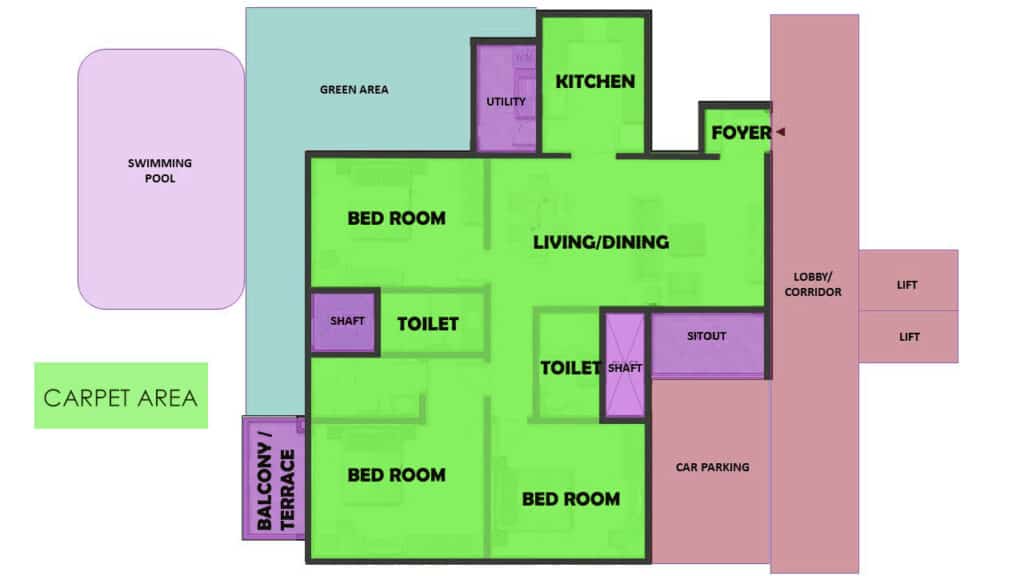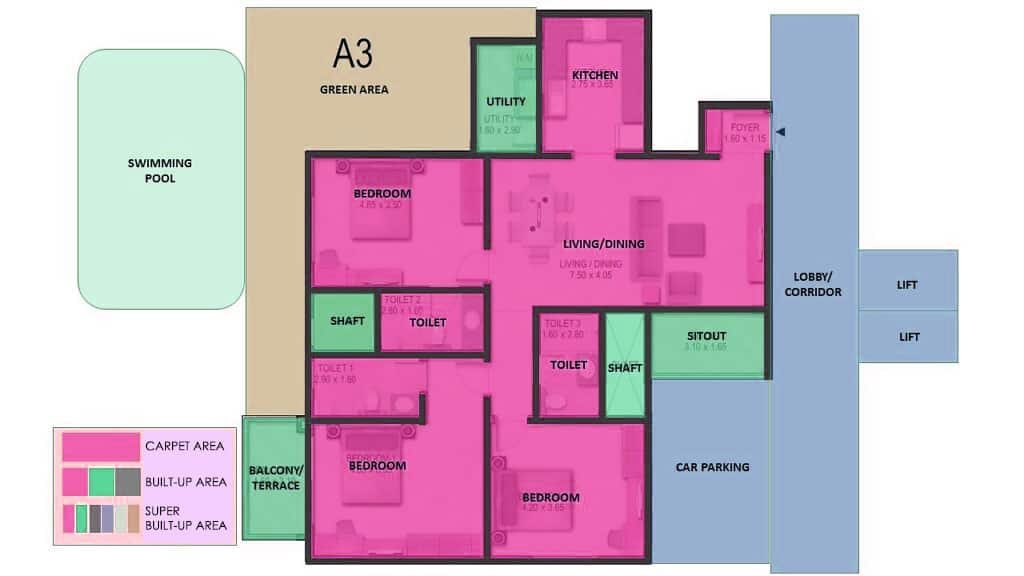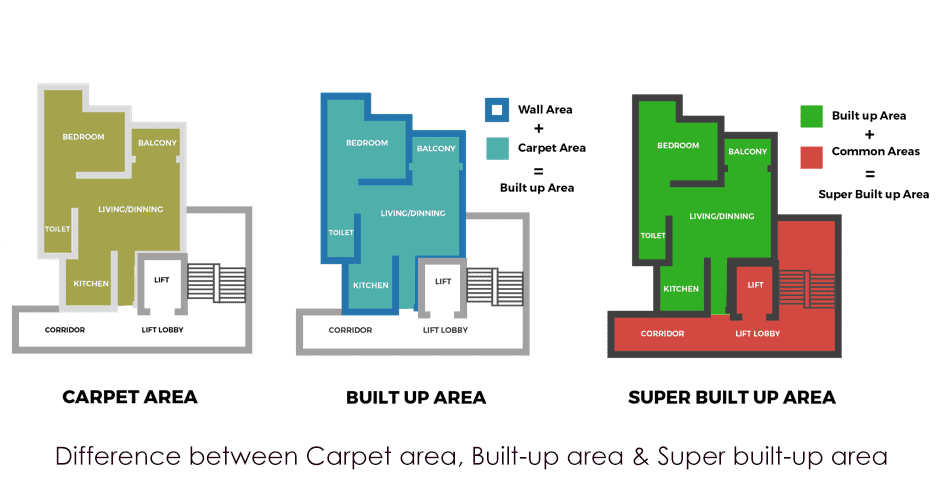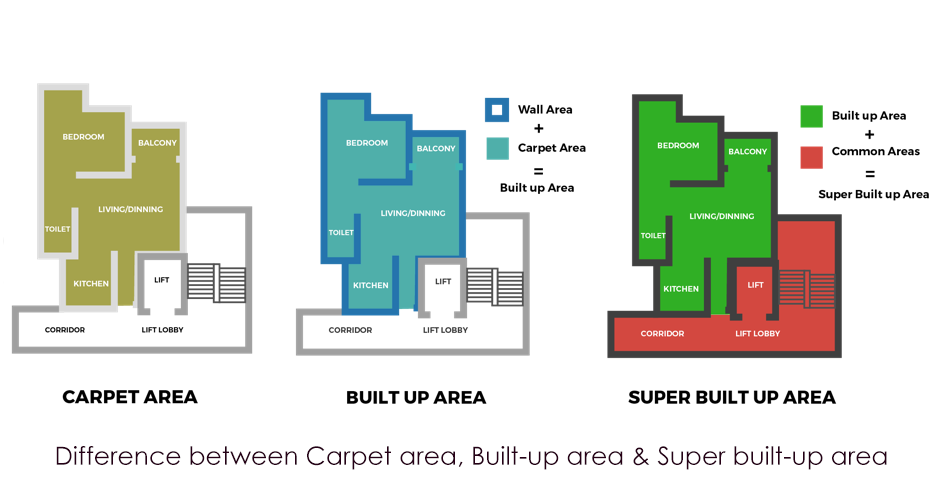Carpet area
What is the carpet area?
The portion of the house or apartment that a carpet might be used to cover is the “carpet area.” In certain areas, the term “carpet area” is synonymous with “net useable area.” Simply put, “carpet area” refers to the space in your house that is eligible for placing carpeting. It takes into account the width of the interior wall but does not take into account the balcony or patio. The carpet area corresponds to the space that is between the inner walls. Also, if there is a staircase inside the apartment, it will be a part of it.

These phrases were commonly overused by real estate developers in India, who lied to consumers about the actual useable size of the property and coined elaborate terminology in order to provide a false impression of having a huge amount of space.The Real Estate (Regulation and Development) Act of 2016 has changed the way real estate is regulated, it is now required of all builders to sell apartments based on the carpet area. This requirement came into effect on May 1, 2017.
According to RERA, the area that is covered by an apartment’s external walls, areas that are under service shafts, the balcony or verandah, and any open terrace area are not included in the calculation of the apartment’s net usable floor area. However, the area that is covered by the apartment’s internal partition walls is included in the calculation.
Carpet area calculation
Carpet area is the sum of the areas of the bedroom, living room, balcony, and bathrooms, minus the width of the interior walls.
Usually apartment’s carpet area probably takes up around 70 percent of the total built-up space in the unit. In most circumstances. Therefore, if a property has a built-up size of 700 square feet, the carpet area of the property would normally be 490 square feet.
Importance of carpet area:
The estimate of the property’s area, as well as the amount of space that you would have in return for the cost of buying the property, is very important. It should come as no surprise that the cost would increase proportionately with the size of the area. In a similar manner, the cost is reduced if there is a lesser amount of room. As a result of RERA, construction companies are now under a legal obligation to specify the carpet area when measuring pricing units.
During the process of constructing a project that is now under development, measures have been made for both a raise and a drop in its measurement. In the event that the carpet area is lowered while the building is being constructed, the builder is obligated to reimburse the customer for the excess money within forty-five days, together with yearly interest on the sum.
In the event that the carpet area of the unit is increased, the developer has the option of asking the buyer to pay the additional cost. Nevertheless, RERA stipulates a maximum restriction of 3 percent on the increase that may be made to the carpet area.
Read more: 5 Types of Parapet Wall-Purpose, Construction & Uses
What is a built-up area?
The area that is covered by the carpet in your flat or apartment, in addition to the area that is enclosed by the inner walls and the balcony,, is referred to as the built-up area. Nearly 30% of a housing unit’s total space is utilised for the construction of the inside walls and balconies in housing flats in India. If the developer informs you that the built-up size of the unit is 1,500 square feet, then you may anticipate that the apartment’s net useable space, also known as the carpet area, would not be more than 1050 square feet.
According to RERA, the built-up area comprises the carpet area as well as any other areas that have been approved by the relevant authorities. These additional areas might include the area of the exterior and inner walls, the area of any dry balconies, and so on.
Built-up area calculation:
The built-up area of a building is equal to the sum of the carpet area and the wall area; the size of any balconies or corridors is excluded.

Super built-up area
The super-built up area of a unit is calculated by developers by putting together the entire built-up area of the unit and the area that is occupied by common areas. These areas may include the corridor, the lift lobby, the elevator, and other similar spaces. In certain instances, builders would even provide facilities in the shared areas of the development, such as swimming pools, gardens, and clubhouses.
Before the RERA made it mandatory for builders to sell apartments based on the carpet area, they frequently used the super-built-up area as the space-measuring unit, which enabled them to profit from the lack of clarity on space computation. This practise continued after the RERA made it mandatory for builders to sell apartments based on the carpet area.
This practise was widespread before the RERA made it mandatory. They were able to reduce the cost of the property on a per-square-foot basis by switching the unit of measurement to super built-up area. In addition to this, it provided the buyer an erroneous idea that they were buying in a huge property when, in reality, this was not the case.
“Super built-up area is the huge figure that developers want to sell their projects with. Super built-up area includes both the land and the buildings. The figure they arrive at is the result of bringing together the built-up areas and the shared spaces. The super built-up area is also known as the saleable area because it becomes a yardstick for developers to price their customers,” says Vijay Verma, CEO of Sunworld Group.
Let’s say that the price of a property that has a carpet area of 700 square feet is Rs 1,000 per square foot. Under these circumstances, the total cost of purchasing the property will be 700,000 Indian Rupees. A property developer may supply the super built-up area (for example, 910 square feet) and sell the property at a cheaper rate (for example, Rs 900 per square foot), both of which are intended to make the marketing pitch more appealing. Under these circumstances, the total cost of purchasing the home would amount to Rs 8.19 lakhs. The second option seems far more appealing than the first one, especially to a consumer who is not very knowledgeable about buying habits.
Super built-up area calculation
Super built-up area = Built-up area + proportional common area Or Super built-up area = Carpet area (1+loading factor) Take note that the loading would be anywhere from 15% to 50%, depending on the builder as well as the precise location.
Super built-up area calculation
When there are many units on a level, the super built-up area is computed in a different way than it would be otherwise.
Let us imagine that Rohan owns an apartment in a housing society that is located on the third level and has a constructed space of 1500 square feet. Somesh is the proud owner of an apartment that has a built-up space of 3000 square feet and is located on the same level. The entire amount of space dedicated to the floor’s communal areas is 3000 square feet.
Now, in order for the builder to compute the super built-up area of the two apartments, he would divide the ratio of the built-up areas of the apartments into the super built-up area (which is 1:2 in this case), add an additional 1000 square feet to the total built-up area of Rohan’s apartment, and add an additional 2,000 square feet to the built-up area of Somesh’s apartment. Rohan ‘s flat has a super built-up space of 2,500 square feet, whereas Somesh’s unit has a super built-up area of 5,000 square feet.
Difference between carpet area vs built-up areas vs Super built-up area

| Carpet Area | Built-up Area | Super built-up Area | |
| Living room/Hall | Yes | Yes | Yes |
| Bedroom | Yes | Yes | Yes |
| Dining room | Yes | Yes | Yes |
| Kitchen | Yes | Yes | Yes |
| Bathroom | Yes | Yes | Yes |
| Pooja room | Yes | Yes | Yes |
| Study room | Yes | Yes | Yes |
| Balcony | No | Yes | Yes |
| Utility areas | No | Yes | Yes |
| Staircase (inside the house) | Yes | Yes | Yes |
| Staircase (outside the house) | No | Yes | Yes |
| Terrace | No | Yes | Yes |
| Verandah | No | Yes | Yes |
| Lift | No | No | Yes |
| Lobby | No | No | Yes |
| Garden | No | No | Yes |
| Swimming pool | No | No | Yes |
